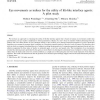Free Online Productivity Tools
i2Speak
i2Symbol
i2OCR
iTex2Img
iWeb2Print
iWeb2Shot
i2Type
iPdf2Split
iPdf2Merge
i2Bopomofo
i2Arabic
i2Style
i2Image
i2PDF
iLatex2Rtf
Sci2ools
IWC
2007
2007
Eye movements as indices for the utility of life-like interface agents: A pilot study
We motivate an approach to evaluating the utility of life-like interface agents that is based on human eye movements rather than questionnaires. An eye tracker is employed to obtain quantitative evidence of a user’s focus of attention without distracting from the primary task. The salient feature of our evaluation strategy is that it allows us to measure important properties of a user’s interaction experience on a moment-by-moment basis in addition to a cumulative (spatial) analysis of the user’s areas of interest. We describe a pilot study in which we compare attending behavior of subjects watching the presentation of a computer-generated apartment layout and visualization augmented by three types of media: an animated agent, a text box, and speech only. The investigation of eye movements revealed that deictic gestures performed by the agent are more effective in directing the attentional focus of subjects to relevant interface objects than the media used in the two control co...
| Added | 15 Dec 2010 |
| Updated | 15 Dec 2010 |
| Type | Journal |
| Year | 2007 |
| Where | IWC |
| Authors | Helmut Prendinger, Chunling Ma, Mitsuru Ishizuka |
Comments (0)

